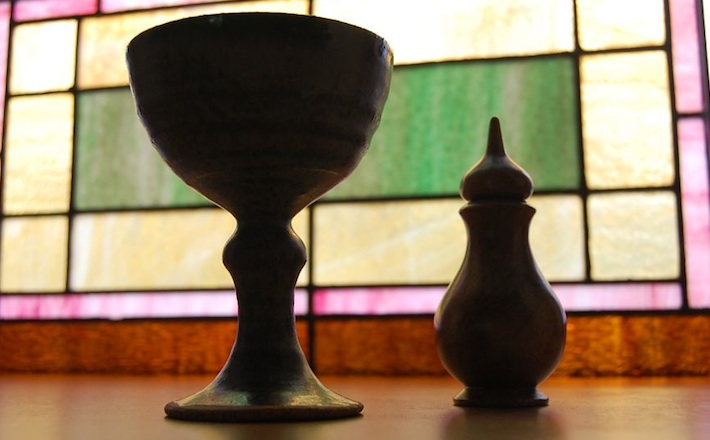Commentary on Isaiah 58:1-12
A prominent strand of Old Testament theology portrays the history of God’s people as cyclical — a cycle in which the people cry out for help, God saves them, but then they forget, go astray, and find themselves in trouble again. (Judges 2:18-20 offers a concise and paradigmatic summary.)
[Find commentaries on Joel 2:1-12, 12-17, by Terence Fretheim (2014), Esther Menn (2013), and others.]
The book of Isaiah has a similar shape: the earliest portions of the book report God’s judgment against Israel and Judah in the eighth century, then after the devastation Babylonian exile (which is hardly reported at all), chapters 40 and following offer comfort and restoration. But the final chapters of the book (56-66) reflect still another historical situation, in which the prophets’ hopes for the restored Judah and Jerusalem have been frustrated once again. Where Isaiah 40 had invited a herald of good tidings to offer comfort to the people, Isaiah 58 begins with a command to “announce to my people their transgression.”
There are strong echoes of the book’s early oracles, such as Isaiah 58:2’s references to the same righteousness (sdqh) and justice (mspt) that the Lord was said to expect in 5:7. Much of the chapter in fact condemns similar kinds of social injustice, such as the abuse of workers and failures to free the oppressed, feed the hungry, clothe the naked, house the homeless, and oppose affliction. The recurrent image of the yoke (mwth vv. 6, 9) is a symbol of subjugation, especially in economic forms. It functions in this way in native Assyrian texts, in which the “yoke of Assyria” means the heavy burden of taxation imposed on conquered nations, a reality that is reflected in Isaiah 9:3 and 14:25. Jeremiah’s public sign-act about Babylonian domination in Jeremiah 28 also employs the yoke as a symbol. Another term for yoke (‘l) is used in 1 Kings 12 of Rehoboam’s ill-advised oppression of the northern tribes through forced labor. The use of this image for both foreign and domestic forms of economic oppression is significant; in the Old Testament’s moral universe, the one who oppresses his fellow Israelites or Judeans is seen as no better than an oppressive foreign emperor.
Isaiah 58:3 also echoes other portions of the book, drawing on the characteristically Isaianic theme of seeing (r’h) and knowing (yd’). For example, Isaiah 29:15 caricatures those who think God does not see or know their evil deeds; 41:20 says that God’s power is seen and known; 44:18 contrasts God with idols who neither see nor know; 61:9 and 66:14 proclaim that God’s work will be seen and known. See also 5:19; 6:9.
For all these similarities, there is a different angle to the chapter’s critiques: the people at whom they are aimed are concerned to seem outwardly righteous. It quickly becomes apparent that the prophet is sarcastic when he says, “day after day they seek me and delight to know my ways” (Isaiah 58:2). Their outward piety is on display when they are portrayed as asking, “Why do we fast, but you do not see? Why humble ourselves, but you do not notice?” (Isaiah 58:3). It seems that the people are, as so often before, dissatisfied with God. It is not noticed enough that ancient Israel and Judah were every bit as much religious “marketplaces” as our own cultures, and the temptations of Baal (Hosea 2), various goddesses (e.g., Jeremiah 44), and the divinized dead (Isaiah 8:19-20) were strongly felt.
There are various indications that fast days were kept regularly after the destruction of Jerusalem (e.g., Zechariah 8:19). These were intended to supplicate the Lord for forgiveness and blessing (Ezra 8:21). But the prophet describes the fasts as full of violence and oppression of workers (perhaps they were not given rest as the Sabbath commandment orders). Therefore he condemns the fast days — “the fast that I choose,” says the Lord, “is to loose the bonds of injustice” (Isaiah 58:6). This is quite reminiscent of the condemnation of sacrifices in Micah 6:6-8: “what does the Lord require of you but to do justice, and to love kindness, and to walk humbly with your God?”
The clearest indicators in the passage of its late provenance are the references to rebuilding in Isaiah 58:12: “Your ancient ruins shall be rebuilt; you shall raise up the foundations of many generations; you shall be called the repairer of the breach (???), the restorer of streets to live in.” Holes in the walls of Jerusalem were among the problems that reportedly faced Nehemiah when he returned to govern the city (Nehemaiah 4:1; 6:1), and these may also have been the subject of this exhortation.
This passage resonates with various aspects of our own times. Like those who claimed to keep the fast but did not practice peace and justice, many self-professed Christians are now happy to enjoy their rest at the expense of exhausting their fellows, at home and abroad. The international economy has become a finely tuned machine for exploiting and disempowering labor in favor of capital. Under such conditions, the outward practices of piety are hollow shells; the community of faith does not flourish because it is recognized as hypocritical — or as Jesus put it, its people are “whitewashed sepulchres” (Matthew 23:27).
Ash Wednesday is the first day of Lent in the Western Christian tradition. It is fitting, therefore, that even as the text calls for repentance, it also looks forward with hope, much as Lent looks toward the renewal of Easter. The promise in Isaiah 58, the people are told, is that is that if they practice righteousness and justice, “your light shall break forth like the dawn” (v. 8), and “your light shall rise in the darkness” (v. 10). The theme of light and darkness is another one that is pervasive in Isaiah (2:5; 5:20; 9:2; 13:10; 42:16; 45:7; 50:10, etc.), and culminates in some of the book’s most glorious promises, e.g. “Arise, shine; for your light has come, and the glory of the Lord has risen upon you” (60:1). This light is interpreted in the New Testament as the light of Jesus Christ, which “shines in the darkness, and the darkness did not overcome it” (John 1:5).
It is not surprising, then, that there are profound resonances between Isaiah 58’s call on the people and the mission of Jesus to “bring good news to the poor … proclaim release to the captives … to let the oppressed go free” (Luke 4:18; cf. 1:52-53). Jesus is the light, but those who would follow him are called to reflect his light: “let your light shine before others, so that they may see your good works and give glory to your Father in heaven” (Matthew 5:16; cf. John 1:7).


February 18, 2015